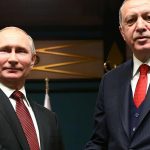By Guldem Atabey
The countdown to Turkey’s March 31 local elections saw a mild lira depreciation that raised further questions about the performance of the Turkish currency. Despite the funding cost of the central bank remaining stable at 24 percent, the lira’s loss of about 2.5 percent in almost a week was puzzling since the central bank is unlikely to ease its monetary stance anytime soon.
The likely contraction of the economy in the first quarter of 2019 and businesses’ heavy external debt problems have already led to talks of the need for an IMF programme after the March 31 polls. Though the economic situation seems to be weighing on the ruling Justice and Developments Party (AKP), the government has fiercely denied the need for IMF funding. The rosy picture drawn by Treasury and Finance Minister Berat Albayrak is nowhere close to the real economic situation. Thus, the guessing game about the lira’s performance for the second half of the year continues.
Both external events and domestic affairs affected the lira in the past few weeks. Federal Reserve Chairman Jerome Powell has markets that the Fed would be patient before imposing an interest rate rise.
The cautious messages, together with the Fed’s efforts to fine-tune the markets for a smooth ending to monetary expansion, immediately impacted emerging market currencies and the rest of the financial markets. The Fed’s rate hikes and its balance sheet normalisation are important to keep the dollar strong throughout 2019 and perhaps well into 2020.
The economic contraction in Turkey and external dynamics point to further weakness for the lira. But the central bank’s Monetary Policy Board meeting on Wednesday kept its policy rate at 24 percent. The wording of its announcement was the same as that of last month, indicating the bank has no intention of easing monetary policy. Nevertheless, markets fear political pressure could lead to a rate cut in the future.
While the main reason for the lira’s mild depreciation over the past two weeks is messages coming from the Fed, politics is also affecting sentiment.
Turkey’s plans to take delivery of Russian S-400 air defence missiles is at the heart of diplomatic tension with the United States. Pentagon Spokesman Eric Pahon said Turkey’s acquisition of the Russian S-400 air defence system would have grave consequences for U.S. -Turkey relations. The United States would also block the deployment of new generation F-35s fighter jets in Turkey.
The ongoing negotiations with the United States are likely to result in a deal as the Turkish government seems to be using the S-400 purchase as leverage to strengthen its position on a range of issues. But in the meantime, statements from both sides will add to tension and weigh on the lira.
U.S. President Donald Trump’s decision to strip some Turkish exporters of their preferential trade status can be seen as an extension of the S-400 issue. The U.S. government is now trying a similar approach to that it successfully used last year to put pressure on Turkey to release American pastor Andrew Brunson, who was jailed on terrorism charges.
With the global economy slowly cooling and tensions rising with the United States, Turkey’s hopes of improving the economy through higher exports appear more difficult. The lira looks prone to further devaluation after the March 31 local polls due to a lack of external funds, the Fed’s ongoing balance sheet reduction and Turkey’s heavy external debt obligations.
The level of expected lira devaluation will be up to the Turkish government. It could either be capped through a credible external funding source like the IMF that would only come hand in hand with orthodox economic policies, or another free fall devaluation appears on the cards.
Source: Ahval News



